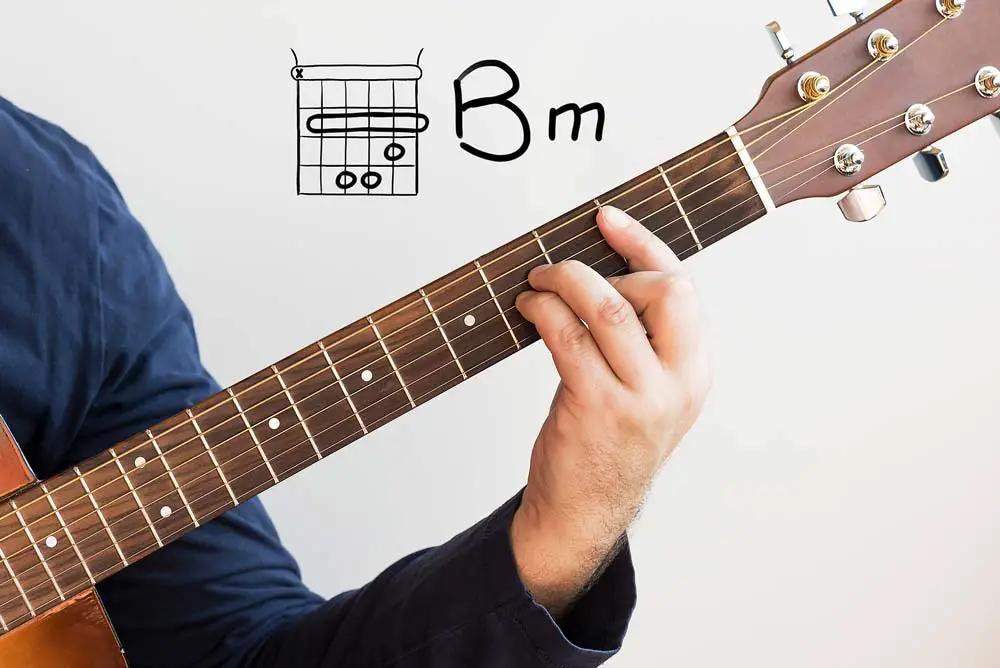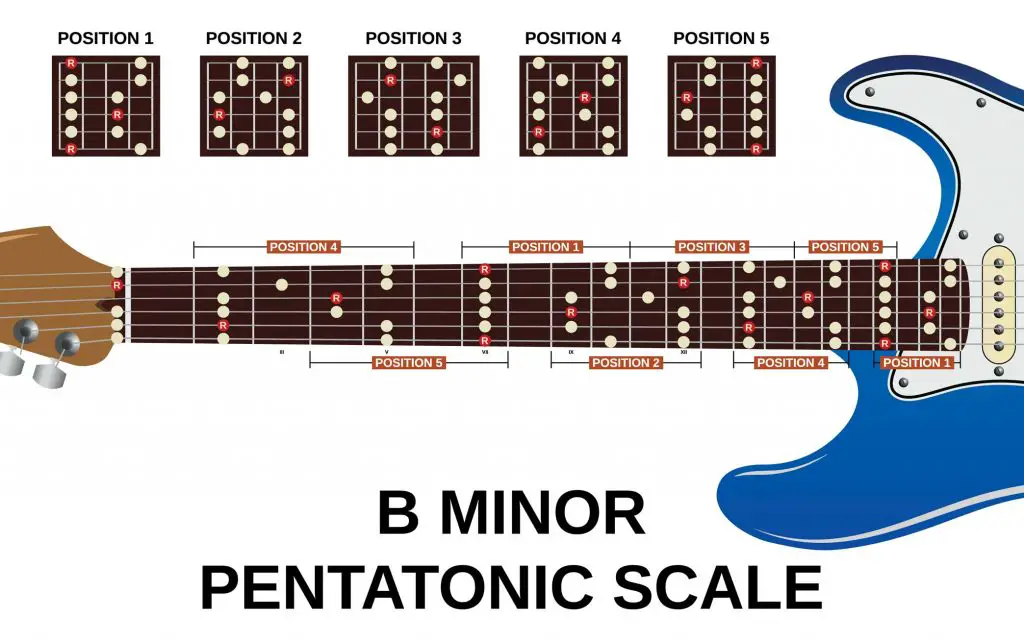The B minor guitar chord (also commonly abbreviated to Bm guitar chord) is one of the most common chords played on the guitar. Its popularity spreads throughout several musical genres and is an incredibly diverse and useful chord to have in your repertoire.
Bm is probably one of the first barre chords that you will learn, and for that reason, it’s often one of the most difficult for beginners. But fear not, in today’s article, we will look at a variety of ways to play B minor, with and without the barre!
If you’re already familiar with the basic B minor chord guitar shape, then feel free to skip ahead to the intermediate and advanced sections below.
Beginner
B Minor – Simplified Triad
The easiest way for beginners to get to grips with B minor is to play the chord’s simplified triad version. When we play a triad, it simply means that we only play the 3 necessary notes that form a B minor chord, which in this case are B, D, and F#.
Why is it easier to play Bm this way? Well, you may already be familiar with certain open chord shapes such as A and G, which can also be played with only 3 fingers. Similarly, the B minor triad can be played with only 3 fingers!
Take a look at the diagram below to practice the triad shape:
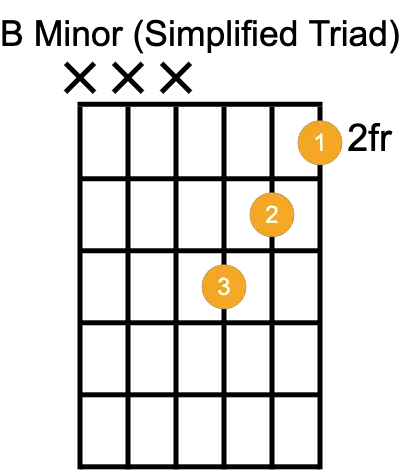
B Minor – 4 Finger Version
So you’ve become familiar with the simplified B minor triad, good work! Now, by simply adding 1 more note, we can take our B minor to the next level and help give it some more depth of sound. This is great practice for every beginner because it’s necessary to use your little finger to play the chord.
We use the same shape as the Bm triad, but we move our ring finger “up” one string to the D string and put our little finger in the space where our ring finger was previously positioned. Be careful not to strum the low E and A string.
This shape of B minor chord is fairly popular, and it will take you a long way until you master barre chords!
Check out the finger positions here:
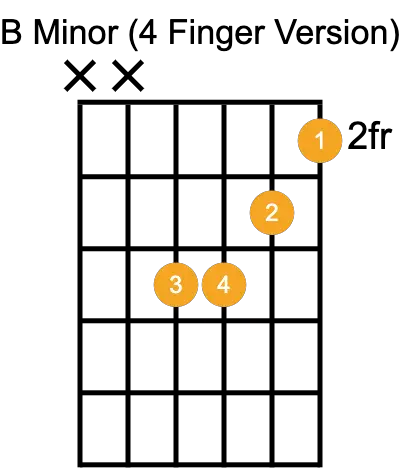
B Minor – 2nd Fret Barre
If you’re new to the guitar, you may very well be wondering, “What is a barre chord?” A barre chord is when you flatten your index finger along a fret to play multiple notes at once. Learning to barre can take a while because you need to develop finger strength and become comfortable with the technique.
Don’t worry if you’re hearing a buzzing sound or aren’t hitting each note clearly because every beginner has these same issues. It might sound a bit like a cliche, but practice really does make perfect when learning barre chords!
Barre chords are very diverse and can be played all along the fretboard, so it’s important to stay patient and master the technique.
In the diagram below, you can see how to play a B minor barre chord. You will probably notice it’s the same notes as the 4 finger version (but with the added barre, of course).
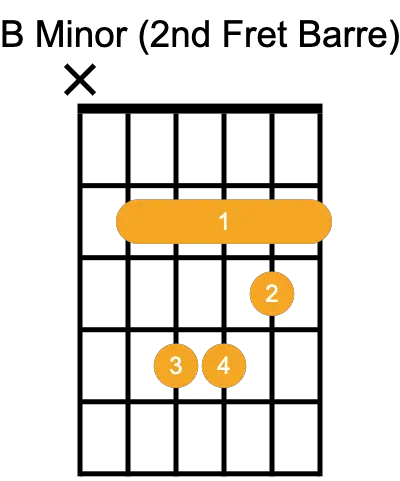
Practice
A common chord progression that you can practice in the key of D major is as follows:
- D, A, Bm, G
By using the same chords, we can rearrange them to play a popular progression in the key of Bm:
- Bm, G, D, A
Intermediate
Now that you’ve got the B minor basics down to a tee, we can look to develop your chord knowledge by moving up the fretboard and exploring new positions.
B Minor – 7th Fret Triad
Hopefully, if you’ve come this far, you’re already familiar with triads (and even realized how easy they are to play)! The 7th fret Bm triad is no exception to the rule and is an incredibly simple way to play a ‘higher-pitched’ B minor chord.
What’s great about this triad is that you can play it with one finger while leveraging your recently perfected barre technique!

B Minor – 7th Fret Barre
Aside from the shape used in the 2nd fret barre chord, there is another commonly used minor barre shape. If you’re only accustomed to the prior, this new positioning can take a little time to become natural because you don’t use your middle finger to provide any additional support.
This shape is important because chords such as G and F minor can be played with ease in combination with open chords on the 1st, 2nd, and 3rd fret!
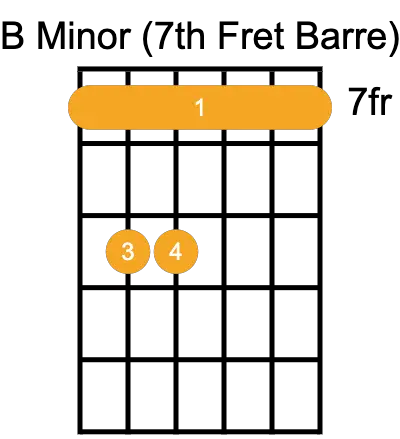
B Minor – 11th Fret Triad
The final chord shape that we’re going to focus on is located on the 11th fret. All 3 notes of the chord need to be played with separate fingers, and it’s important that you don’t strum any irrelevant strings (noted by the X’s on the chart).
One of the main advantages of playing a B minor chord on the 11th fret is that it ties in comfortably when playing chord progressions around the 12th fret. It’s also useful to play interluding riffs between chord strums, so you don’t need to be constantly moving up and down the guitar neck.
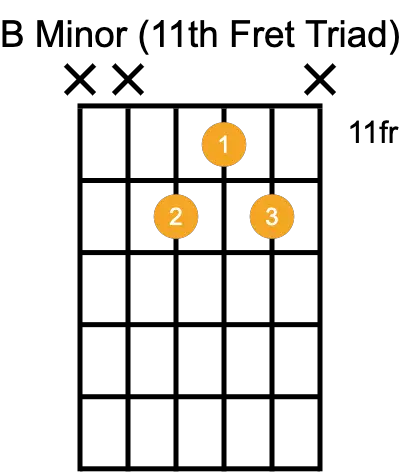
Advanced
B Minor Pentatonic Scale (Solo)
At the advanced stage (hopefully), you now have all the chords in the bag and are ready to explore soloing over B minor! One of the most common scales to do so is the pentatonic scale. Considering it’s one of the most versatile and easy to play scales on the guitar, it’s no surprise that its popularity is incomparable.
What makes the B minor pentatonic so easy to play is that it only uses 5 notes instead of a traditional scales’ 7 notes.
The 5 notes that you are going to use are:
- B, D, E, F#, and A.
There are 5 different scale positions to perfect. These will allow you to riff up and down the fretboard at will!
Remember to use your little finger when playing notes that are over 2 frets apart. It’s a great habit to have, especially when learning more complicated scales.
Have a look at the image below and take your time to master the B minor pentatonic scale.
What’s Next?
Congratulations! You’ve made it through all 3 sections and perfected the B minor guitar chord. If you want to continue developing your B minor guitar skills, check out our How to Play Bm 7th Chords article (coming soon) to add a unique touch to your playing style.
Feel like sharing? We always love to hear about your B minor learning experience and how you use this new chord in your playing repertoire. Comment below with any questions, and we’ll be happy to help.


